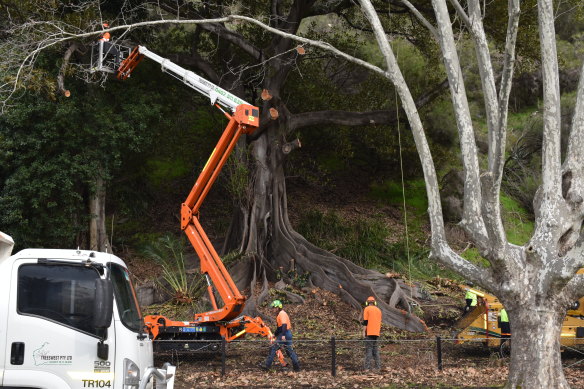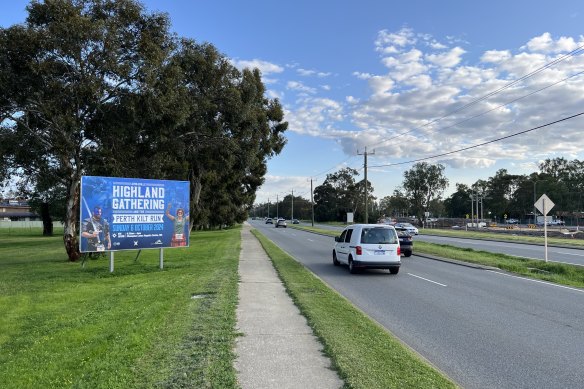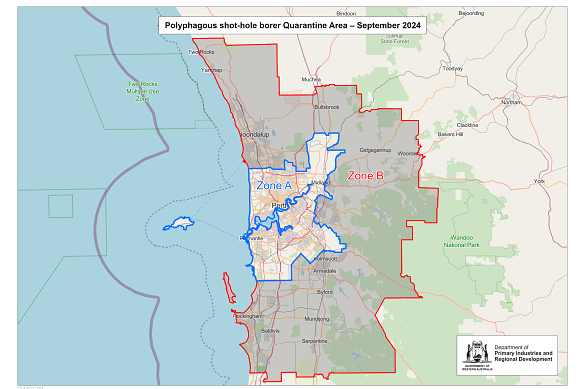This was published 9 months ago
Send me a sign: Councils say state too slow in shot-hole borer fight
Frustrated Perth local governments say the state is not pulling its weight in the fight against the polyphagous shot-hole borer as it falls short on physical signage communicating important quarantine zones that fall over the Perth metro area.
More state support to stop the borer is top of the WA Local Government Association’s pre-election wishlist released last week, and they have been lobbying the government hard on the issue of signage but, as of Friday, it had been to no avail.

Workers beginning to remove a shot-hole borer-infested Moreton Bay fig last month.Credit: Emma Young
“The campaign must provide location-specific materials for those within Zone A and B of the quarantine area, and those outside,” WALGA deputy president Paul Kelly said.
“Local governments outside the current quarantine zone are keen to play their part in stopping the spread of the borer to their communities.
“Things like freeway digital billboards, and mobile message boards at the boundaries of the quarantine zone will increase basic public awareness.”
On Friday, WAtoday visited three major road routes crossing A and B quarantine zones in the cities of Armadale and Gosnells and found no signage.

Where quarantine zones A turns to B in Kelmscott on Friday.Credit: Hamish Hastie
This included where Zone B ends on Albany Highway 60 kilometres south east of Perth and where Zone A turns to Zone B in Kelmscott – near the productive fruit-growing areas of Karragullen and Roleystone.
In contrast, we came across several signs for the European house borer, an LED sign urging residents to sort out their firebreaks and two signs advertising the City of Armadale’s Highland Gathering and Kilt Run on October 6.
The Shire of Mundaring was so desperate last week that it passed a motion giving authority to its chief executive to plead with Main Roads WA to set up LED signage alongside Great Eastern Highway alerting drivers to the quarantine zone and rules.
The shire’s motion also called for escalated research efforts and partnerships with neighbouring councils and government agencies to launch a community awareness campaign.

The quarantine area for polyphagous shot-hole borer has been expanded to cover the entire Perth metropolitan area and now includes two zones to help contain the spread of the destructive pest.
Shire President Paige McNeil said local governments were having to take matters into their own hands to stop the spread of the pest that could be catastrophic to the horticultural and agricultural industries of the Perth Hills and Wheatbelt.
“It is disappointing that the response to date hasn’t addressed this human-assisted transport and the further spreading,” she said.
“If the borer gets into the Shire of Mundaring and beyond into the Wheatbelt, it will be both environmentally and financially catastrophic for us.”
Agriculture Minister Jackie Jarvis said large traffic signs showing quarantine information would be placed around WA’s main roads ahead of this weekend.
She said since the quarantine area was expanded last month the Department of Primary Industry and Regional Development had developed and produced signs that had been offered to all local governments covered.
“The first delivery of these signs has already been completed with additional deliveries going out next week. DPIRD will continue to work with local governments regarding supply and recommended placement of these signs.”
Jarvis defended her government’s handling of the borer outbreak and said the department had run an extensive awareness campaign which included a digital sign on the Yagan Square tower, community meetings, displays at events, media, social media, website updates and letterbox fliers.
She said since August 2021 150 staff have inspected more than 2 million trees and 3000 surveillance traps have been set up across Perth.
The state has so far committed $4.7 million to the borer response while the federal government, which ultimately oversees the biosecurity response, has committed $19.9 million.
Spring will provide ideal weather conditions for the borer to flourish.
PSHB quarantine restrictions
Residents in Zone A:
- cannot move untreated or unseasoned wood outside Zone A, unless chipped to pieces that are 2.5 cm or less in diameter,
- cannot move plant materials, including living plants, that are greater than 2 cm in diameter outside Zone A,
- must ensure any machinery used to handle green waste is cleaned before it can be moved outside Zone A.
Residents in Zone B:
- cannot move untreated or unseasoned wood outside the Quarantine Area, unless chipped to pieces that are 2.5 cm or less in diameter,
- cannot move plant materials, including living plants, that are greater than 2cm in diameter outside the Quarantine Area,
- can move wood or plant materials, including living plants, into Zone A,
- must ensure any machinery used to handle green waste is cleaned before it can be moved outside the Quarantine Area.
Source: DPIRD
As of May, more than 3000 trees, including enormous shady trees like London plane trees and Moreton Bay figs, had been pulped as a result of infection.
Late last month it was found to have skipped the original quarantine zone into Gosnells, Armadale, Kalamunda and Ellenbrook.
Since then a much wider quarantine zone has been established limiting the type and amount of plant matter that can be transported around Perth and beyond (see breakout box below).
WALGA deputy president Paul Kelly said human transport was a main driver of borer spread.
“We know that there is a longstanding practice of taking wood and green waste from the metro to surrounding rural areas,” he said.
“Unfortunately, if this practice continues – which will happen without effective communication – we could see significant environmental, social and economic impacts.”
To see the latest quarantine updates visit https://www.agric.wa.gov.au/borer. Suspicious insect activity can also be reported via the MyPestGuide reporter app.
Start the day with a summary of the day’s most important and interesting stories, analysis and insights. Sign up for our Morning Edition newsletter.